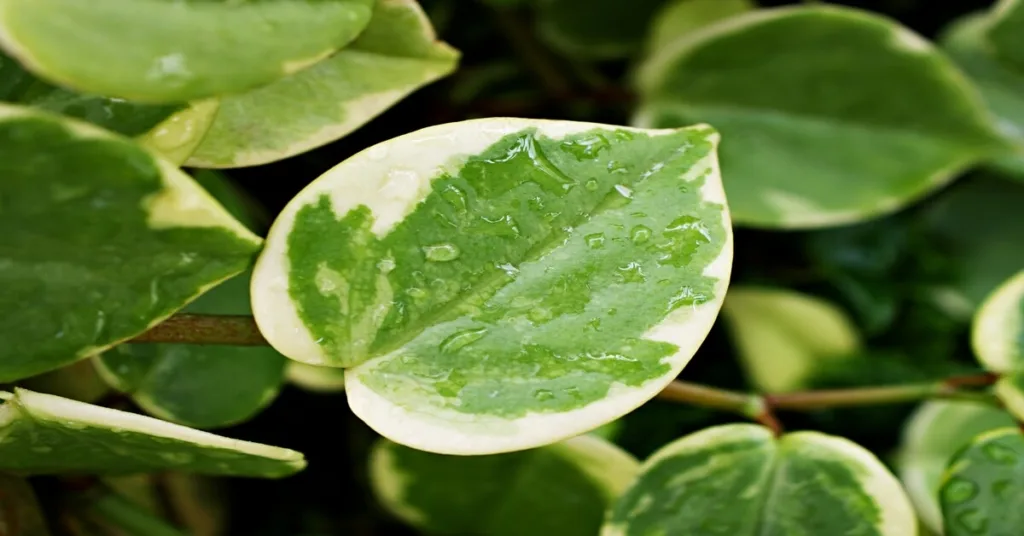Peperomia scandens is a perennial, vining plant in the pepper (Piperaceae) family. It is often referred to as Peperomia scandens green, radiator plant, hanging peperomia, and false philodendron. It comes in a variegated form, Peperomia scandens variegata, which is commonly called Cupid Peperomia.
The origin of Peperomia scandens is the tropical rainforests of Central and South America. It can reach a height of 36 inches if you give it something to climb on. Individual vines can grow up to 5 feet long.
In this article, we’ll tell you how to care for false philodendron. We’ll also tell you about its flowers, Cupid Peperomia, and answer some of the most common questions about growing this plant. Radiator plants are hardy, easy to care for, and can help improve the indoor air quality in your home.
Peperomia scandens Care
Peperomia scandens don’t need much special attention to thrive indoors. As long as they get the right amount of sunlight and water, they will flourish in your home.
You can provide Peperomia scandens green with a trellis if you want it to grow upwards. Alternatively, you can place it in a hanging planter and allow the beautiful foliage to cascade downwards.
Soil
Moisture-retentive, well-draining soil is ideal for growing Peperomia scandens. The pH should be slightly acidic. Orchid mixes work great since they provide everything false philodendron needs.
You can easily make your own orchid mix by combining equal parts of peat moss, perlite, and pine bark.
To improve drainage, plant your Peperomia scandens green in a clay pot which will help wick away excess moisture from the soil. Also, make sure the pot you use has plenty of drainage holes.
Watering
Improper watering is one of the worst things you can do to Peperomia scandens. Both overwatering and underwatering can lead to health issues for this plant.
You should only water your Peperomia scandens when the top two to three inches of the soil are dry. Before watering, stick your finger into the soil to check for moisture.
If you have a saucer underneath the pot, make sure you dump out any excess water after 15 minutes. Allowing it to sit in water can lead to root rot issues.
Lighting
Peperomia scandens green grows best when it has moderate to bright indirect sunlight. Ideally, it should get about 8 hours of sunlight each day.
Direct sunlight can cause the leaves to be burned and eventually fall off. If you don’t provide enough sunlight, the plant may start to drop leaves.
Humidity & Temperature
Radiator plants evolved in the tropics near the equator. So it makes sense that they prefer higher humidity and warmer temperatures.
Keep temperatures between 60 and 80 degrees Fahrenheit for optimal growth. Peperomia scandens won’t tolerate temperatures below 55 degrees Fahrenheit for very long.
Humidity should be kept between 40 and 70 percent to promote healthy growth. You can increase humidity around it by placing a pebble tray with water beneath the pot. Alternatively, you can use a humidifier to increase humidity levels.
Fertilizing
Since Peperomia scandens are epiphytes, they don’t require a lot of nutrients to grow well. In fact, you don’t need to fertilize them if they’re planted in the right type of soil.
Propagation
Stem cuttings are the best way to propagate new plants from your mature hanging peperomia. Here’s how it’s done:
- Choose which stem you want to take your cutting from. You need to have 1 to 4 leaves on the cutting you take.
- Cut ¼ of an inch above the leaf you’re leaving on the mature parent plant.
- Plant the cut end of the stem cutting into well-draining moisture-retentive soil.
- Keep the soil moist for at least 4 weeks to allow the roots to develop.
- After about 8 weeks, you can transplant your new Peperomia scandens into a larger pot.
Diseases & Pests
The most common disease issue for Peperomia scandens green is root rot. You can easily avoid root rot issues by making sure you properly water it. Also, make sure you plant it in the correct type of soil.
Peperomia scandens aren’t particularly susceptible to insect pests. However, typical houseplant pests like fungus gnats, mealybugs, mites, and scales can feed on it. The best way to avoid these pests is to thoroughly check any new plants you bring inside for them.
Even better, quarantine any new plants in a separate room for 2 to 4 weeks. If you don’t see any signs of insects on your new plants during this time, it’s safe to relocate them to areas with other plants.
Toxicity
Peperomia plants, including Peperomia scandens, are not toxic to humans or pets. You can safely grow this plant indoors even if you have children or pets.
Peperomia scandens Flower
The flowers of Peperomia scandens aren’t very showy. They typically emerge near the end of a vine, sometimes individually or in groups. They look like 2 to 3-inch long light-green to whitish spikes.
The flowers of Peperomia scandens don’t produce any scent. When this plant is grown indoors, it rarely produces flowers. Plants grown under optimal conditions have the best chance of producing flowers.
Peperomia scandens Variegated
Peperomia scandens variegata has a distinct leaf coloration that gives it more visual interest. It is commonly referred to as Cupid Peperomia. The leaves have an irregular border that is cream to yellowish in color.
Cupid Peperomia has the same care guidelines as Peperomia scandens.
Other Popular Peperomia Varieties
- Peperomia obtusifolia
- Peperomia argyreia
- Peperomia graveolens
- Peperomia albovittata
- Peperomia puteolata
- Peperomia wheeleri
- Peperomia Moonlight
- Peperomia alata
- Peperomia tetraphylla
- Peperomia polybotrya
- Peperomia clusiifolia
- Peperomia pellucida
- Peperomia Rosso
- Peperomia prostrata
- Peperomia griseoargentea
- Peperomia Silver Frost
- Peperomia angulata
- Peperomia orba
- Peperomia blanda
- Peperomia ferreyrae
- Peperomia rotundifolia

